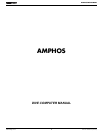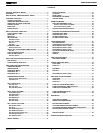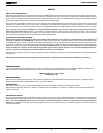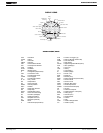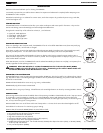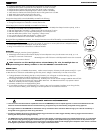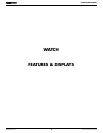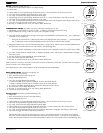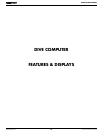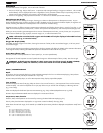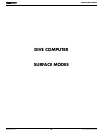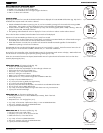
4
AMPHOS DC MANUAL
© 2002 Design, 2012 Doc. No. 12-5301-r01 (12/17/12)
Air Dive - A dive conducted using air (approximately 21% oxygen & 79% nitrogen) as the breathing gas.
Algorithm - A step-by-step mathematical formula designed to accomplish a particular result (i.e. Dive Time Remaining in the Wisdom 3).
Alternate Display - Additional information accessible by pressing a control button.
Altitude Dive - A dive made at an elevation above sea level (> 3,000 feet/915 meters) when no decompression limits are reduced .
Ascent Rate - The speed that a diver ascends toward the surface.
Ascent Rate Indicator - A display that shows ascent rate as a bar graph.
Audible Alarm - A computer emitted tone that alerts the diver to potential danger.
Battery Indicator - An icon displayed while in Surface Time/Wet Mode, indicates a Low Battery Condition.
Caution Zone - The sections of the Nitrogen Bar Graph , O2 Bar Graph, and Ascent Rate Indicator that give a visual warning of a diver’s proximity to
decompression limits, oxygen tolerance limits, and ascent rate, respectively.
Ceiling - See decompression ceiling.
Clean Dive - A dive preceded by 24 hours of no diving activity.
CNS - Abbreviation for the Central Nervous System of the body.
Competitive Dive - A dive conducted for prot or prize.
Compartment - A term applied to the hypothetical modeling of nitrogen absorption in the tissues (more accurate than the term “tissue” because dive com-
puter models have no direct relation to human tissues).
DCS - Abbreviation for decompression sickness, i.e., “the bends”.
DECO - Abbreviation for Decompression.
Decompression Ceiling - The shallowest depth a diver may reach upon ascent without risking decompression sickness.
Decompression Stop - The depth(s) at which a diver must pause during ascent to allow absorbed nitrogen to escape naturally from the tissues.
Deep Stop - A depth at which a diver may choose, but is not required, to pause during ascent to allow absorbed nitrogen to escape naturally from the tissues.
Depth Sensor - an electro-mechanical device that converts water pressure into an electrical signal, that is converted to a visual depth display.
Display - A visual readout of information.
Dive Log Mode - A computer display of previous dive information.
Dive Planner - A display of available dive times at 10 foot (3 meter) intervals from 30 to 190 feet. (9 to 57 meters) used when dive planning.
Dive Time Remaining - A display of the time before a diver must surface based on no decompression dive time remaining or O2 time remaining.
Elapsed Dive Time - Total time spent underwater during a dive between 5 feet (1.5 meters) on initial descent to 3 feet (1 meter) on nal ascent.
FO2 - The fraction (percent / 100) of oxygen (O2) in the breathing gas mixture.
Icon - a small pictorial representation of an operational mode
LCD - Abbreviation for liquid crystal display, an easily viewed low voltage display usually found on dive computers
Maximum Depth - The deepest depth attained during a dive.
Mode - A specic set of functions in a dive computer.
Multi-level Dive - A type of dive prole where the diver spends various times at different depths (opposite of a “Square Wave” dive prole).
Nitrogen Bar Graph - A graphic display of simulated nitrogen absorption on Sherwood dive computers.
Nitrox - A nitrogen-oxygen breathing gas mixture that contains a higher fraction of oxygen than air.
Nitrox Dive - A dive conducted using nitrox (22 to 50 % O2) as the breathing gas.
NOAA - Abbreviation for National Oceanic and Atmospheric Administration.
No Deco - Abbreviation for No Decompression.
No Deco Time Remaining (NDC) - The amount of dive time remaining based on no-decompression status.
No Decompression - Any part of a dive where the diver can surface without requiring a decompression stop.
O2 Bar Graph - A visual representation of oxygen accumulation on a dive computer display.
OTU - Abbreviation for oxygen tolerance unit. A Hamilton's Repex method term for oxygen dose.
Out of Range - The point at which a dive computer can no longer supply correct dive information.
Oxygen Tolerance - Dose or exposure to the physiological affects of elevated levels of oxygen.
Oxygen Toxicity - The adverse physiological affects of exposure to elevated levels of oxygen.
Partial Pressure - The proportion of the total pressure contributed by a single gas in a mixture of gases.
PO2 - Partial pressure of oxygen. The proportion of total pressure of a gas mixture contributed by oxygen.
Repetitive Dive - Any dive that takes place within 12 hours of a previous dive.
Safety Stop - A depth at which a diver may choose, but is not required, to pause during ascent to allow absorbed nitrogen to escape naturally from the tissues.
Square Wave Dive - A type of dive prole where the entire dive is spent at one depth between descent and ascent.
Tissue Compartment - See Compartment.
Transducer - An electro-mechanical device in a dive computer that acts as a depth or pressure sensor.
Transition Period - The rst 10 minutes of surface time after ascending above 3 feet (1 meter) from a dive.
GLOSSARY



